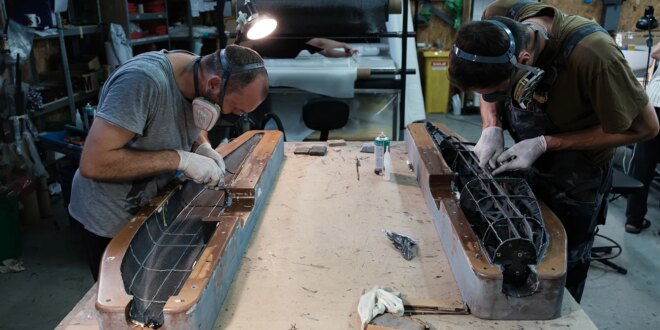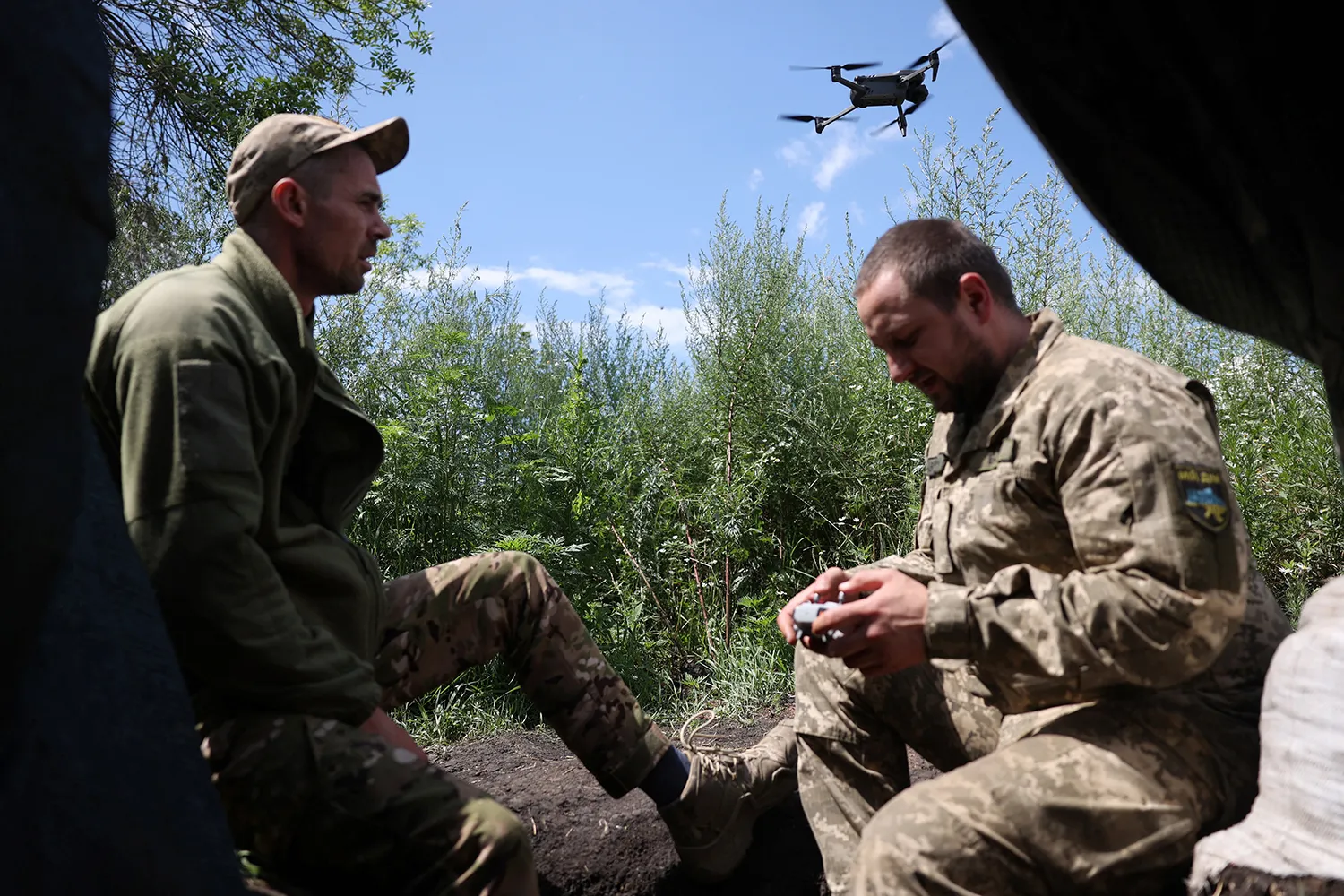Vladyslav Ripko’s day job is working for the Ukrainian government as a financial analyst. But in the evenings and on weekends, he and his friends make drones for the army. He calls their group an “enthusiast collective.” All 12 members volunteer their time. They raise money for drone components on a crowdfunding platform. One volunteer with a 3D printer makes small parts they cannot buy. The team assembles the components in a Kyiv workshop and sends the finished product to the front using a commercial package service.
Unlike many larger Ukrainian drone producers, Ripko’s amateur collective receives no direct help from the government. Still, he said, he benefits from the government’s campaign to support private businesses building unmanned autonomous vehicles, or UAVs, for the armed forces.
Some half-dozen government agencies, including the Defense Ministry and the Ministry of Digital Transformation, have provided tax breaks, start-up grants, and technical support, rolling back the red tape and regulation that hem in much of the rest of the Ukrainian economy. The result is that more than 200 registered companies—some industry insiders count more than 500 producers if you include smaller firms and volunteers in garages—now supply troops with hundreds of thousands of drones a month.
“It’s a fully developed market,” Ripko said, and “none of [it] existed just two years ago.”
The roots of the new industry trace back to before the 2022 invasion. A handful of manufacturers made drones for agricultural uses, and the IT sector was gaining share in a traditional economy dependent on agriculture and metallurgy. Ukraine was already a major exporter of IT services, and officials at all levels of government were racing to digitize public services.
“We’re an engineering culture,” said Dmytro Shymkiv, the former head of Microsoft’s Ukraine office who is now a partner at AeroDrone, one of the country’s largest UAV manufacturers. “When we see a problem, we look for a solution, and it’s often a backdoor solution”—ingenious and inventive. He credits this culture with why Ukrainian drone developers working on a much smaller budget are keeping pace with Russia’s technological advances.
- Men work at a factory producing drones for the Ukrainian armed forces in Kyiv on Aug. 30, 2023. Vitalii Nosach/Global Images Ukraine via Getty Images
- An employee of HentaiFPV Drones builds a first-person-view drone for military use at a factory in Lviv, Ukraine, on Feb. 26. Chris McGrath/Getty Images
No one in Ukraine would have been surprised if the government had decided to seed drone production at a giant state-owned enterprise like those that still dominate much the rest of the economy. “Instead, we placed a bet on the private sector,” said Alex Bornyakov, Ukraine’s deputy minister of digital transformation, “on entrepreneurs and innovators who could move more quickly than government.”
The first step was deregulation—what officials described as dozens of changes to the convoluted Ukrainian legal code. Procedures were simplified, timelines shortened. The customs service waived value-added taxes and import duties on most drone components. Among the most important early changes: a dramatic streamlining of the steps a company must take to be certified to sell to the military.
“It used to take three to five years,” Bornyakov said, “and you needed somebody with influence to help push it through.” Now, drone producers report, the process rarely takes more than two or three months.
A second big step was removing a Soviet-era cap on defense profits. In the old command and control economy, it was illegal for arms manufacturers to generate more than 3 percent a year. “It was a huge damper on innovation,” said Valerii Iakovenko, a co-founder of DroneUA, now one of the largest UAV manufacturers. “Three percent profit left no money for [research and development].” Today, profits are still capped—but at 25 percent. “Suddenly,” Iakovenko said, “investing in [military tech] became profitable. It triggered a revolution in the drone industry.”
Still other changes are designed to support a culture of IT innovation. The Ministry of Digital Transformation’s Diia.City provides tax breaks for a range of IT businesses, including defense tech companies. Member firms pay half as much corporate tax as other Ukrainian companies: 9 percent rather than 18 percent. Their employees pay only 5 percent income tax, less than one-third the norm. Convertible notes—a start-up financing tool borrowed from Silicon Valley that allows loans to later be converted into equity—make it easier to attract investment.
A second initiative, Brave1, provides grants for drone manufacturers, and any company that participates is guaranteed an opportunity to pitch its product to the Defense Ministry. Grants are small, capped last year at $25,000, but often enough to help a start-up build an initial prototype—perhaps adding rotors to a traditional four-rotor device or devising a new electronic jammer to cloak troop movements from enemy drones.
In the early weeks of the war, drones were used primarily for reconnaissance—to spot enemy positions and help artillery gunners direct their fire more precisely. Ukrainians relied on commercial drones such as those used in peacetime to photograph weddings and real estate. Soon, though, both sides had developed attack drones. Some are not much bigger than a hobby drone; others, at first purchased from Turkey or Iran, have wingspans of up to 30 feet.
Ukrainian soldiers fly a drone at a front-line position near the town of Siversk, in Donetsk, on July 12, 2023.Anatolii Stepanov/AFP via Getty Images
Today, both Ukraine and Russia use drones to deliver payloads over hundreds of miles. And the skies over the front line, a landscape otherwise eerily reminiscent of the trench lines at Verdun and the Somme, are filled with the buzz of drones, some monitoring troop movements, others in hot pursuit.
The combination of entrepreneurial energy and government help more than two years into the war has produced a vibrant industry. The most popular products are small, first-person-view suicide drones, 7 to 10 inches long and propelled by rotors. Virtually every front-line unit uses them, and a good operator can dispatch up to 15 a day. The most sophisticated devices resemble small airplanes with fixed wings up to 30 feet wide. (Sea drones also come in all shapes and sizes, and the next frontier is ground drones—autonomous vehicles capable of complex tasks such as medical evacuation, demining, and combat.)
No one is sure how much of the drone market is driven by the central government. Regional governments and even villages also buy UAVs to give to the military; so do a handful of national charities that pool small donations on messaging platforms. Two celebrity charity foundations—one spearheaded by a former TV presenter, Serhiy Prytula, and the other by activist Serhii Sternenko—have raised tens of millions of dollars for drones and other military equipment. But scores of other smaller volunteer groups also collect money on social media.
Not everyone is satisfied with the government’s efforts to support the drone industry. “The authorities have taken some big steps to make things easier for producers,” said Max Subbotin, a spokesperson for Armadrone. “But it’s not enough.”
A growing company founded by veterans, Armadrone specializes in medium-sized, fixed-wing weapons that fly high and unusually quietly to strike targets up to 28 miles away. Both its product lines, the “Punisher” and the “Rex,” are certified by the Defense Ministry. In 2023, the firm won a government contract, and Subbotin said more than 300 units have come back with repeat orders. But this year, the ministry declined to renew the contract. “They say they’re out of money,” Subbotin said.
Roughly half of the Ukrainian budget—nearly $40 billion—is devoted to defense. In the past two years, Kyiv has managed to cover this bill with tax revenue, but it depends on foreign donors, most importantly the European Union and the United States, to pay for everything else, from social security transfers to the health care system. The problem is that foreign funding is precarious and defense needs are ballooning—for drones but also other equipment and salaries.
Armadrone’s predicament is not unusual. Several big manufacturers are waiting for contracts, and officials concede the ministry has become more selective. “Money is very, very limited,” Bornyakov said. “We’re doing what we can.”
Armadrone would like to sell its product abroad and raise the capital it says it needs to continue producing for the Ukrainian military. But there’s a Catch-22. Under martial law, the government won’t allow defense firms to export their product until domestic demand has been met—when all Ukrainian units have everything they need.
A Ukrainian service member assembles a reusable bomber drone in Zaporizhzhia, Ukraine, on March 8.Ukrinform/NurPhoto via Getty Images
Other critics wonder why state-owned banks haven’t been encouraged to lend to drone producers. And many in the industry are hoping that foreigners—governments and defense contractors—will step in, investing directly in companies making drones for the Ukrainian military. Ukraine is already producing weapons for a 14-nation European drone coalition led by the United Kingdom and Latvia, and Denmark and the Netherlands have signed agreements with Kyiv committing to additional purchases.
Some Western skeptics worry that Ukraine is losing the drone war. Former Google CEO Eric Schmidt, who has donated time and resources to support the Ukrainian tech industry, visited in late 2023 and concluded just that. Russia has more than doubled its military spending since its invasion began. Shopping malls converted into munitions plants are producing materiel around the clock. Of particular concern are Russia’s powerful Orlan-10 surveillance drone and its Lancet attack drone, along with Moscow’s edge in electronic warfare, used to jam the other side’s signals and confuse its operators.
Ukrainian manufacturers Shymkiv and Iakovenko contend that Ukraine is catching up and is indeed ahead in some realms. Last December, Ukrainian President Volodymyr Zelensky announced a goal of 1 million drones in 2024; according to the Ministry of Strategic Industries, Ukraine is on track to produce 2 million. Since Schmidt’s visit, Kyiv has fielded a match for Moscow’s Orlan surveillance drones, and in late February, the Ministry of Digital Transformation announced that it had begun mass production of a loitering drone similar to the Russian Lancet. Meanwhile, Ukraine continues to use sea drones to dramatic effect, severely limiting the Russian navy’s ability to operate in the Black Sea.
Ukrainian manufacturers said Ukraine has also caught up with Russia’s initial superiority in electronic warfare. One area where Kyiv is ahead: autonomous navigation in places with no GPS. The question hanging over the future is about money. “The Ukrainian challenge is available funds,” Shymkiv said, “for both R&D and supply.”
Both the government and the drone-makers are already thinking about what comes after the war. Manufacturers are dreaming of civilian applications—short- and long-range delivery, aerial monitoring, first-responder roles—and foreign markets. Officials are wondering if the lessons learned from deregulation of the drone industry can be applied to other sectors, closing the gap between the two Ukrainian economies.
“There will be a huge debate,” said Bornyakov, the deputy minister. “But I’m sure some of what we’ve done will be extended.”
 Unmanned Aerial Vehicle The latest drone news
Unmanned Aerial Vehicle The latest drone news







